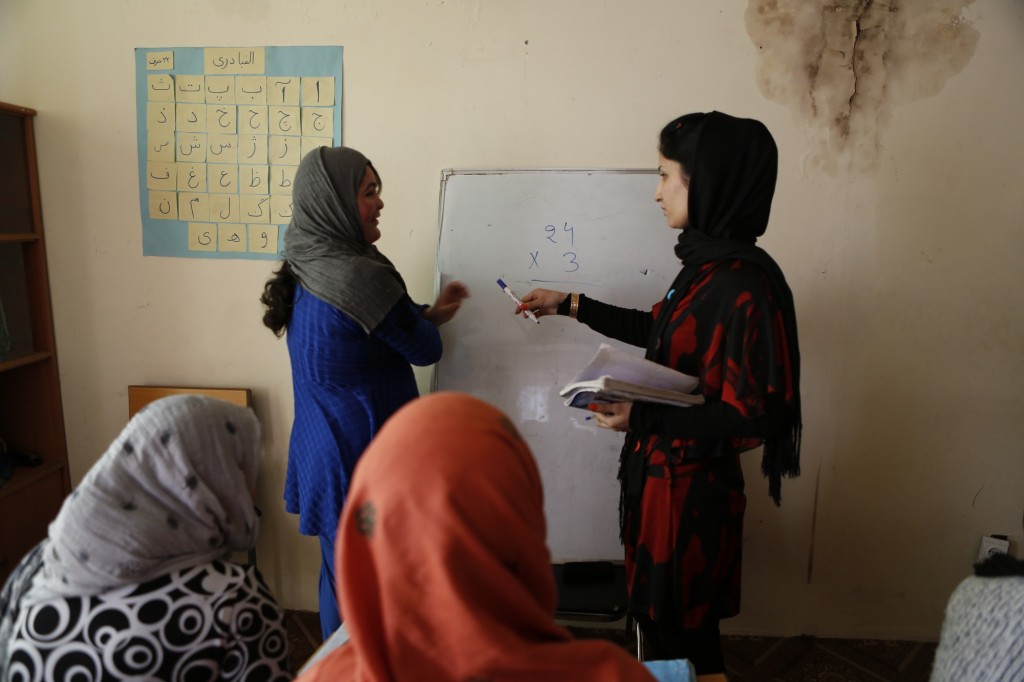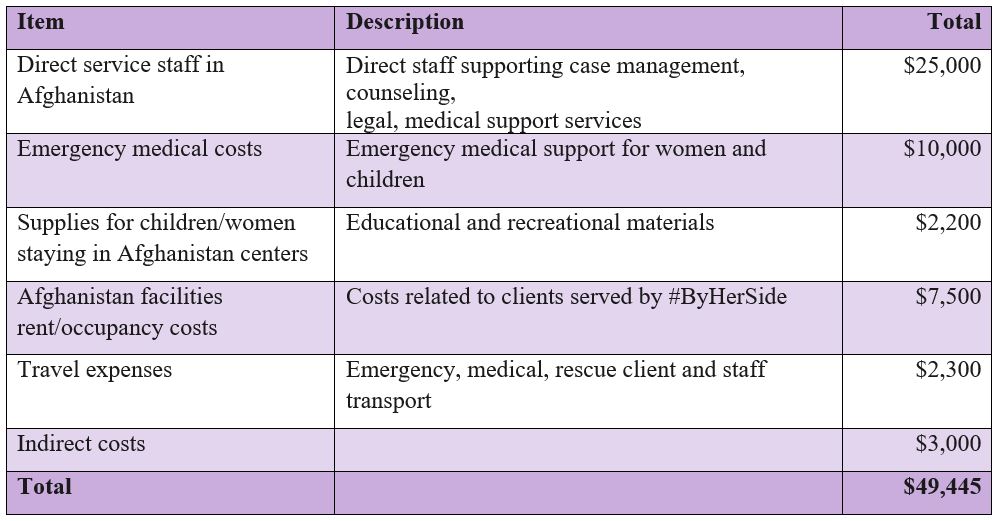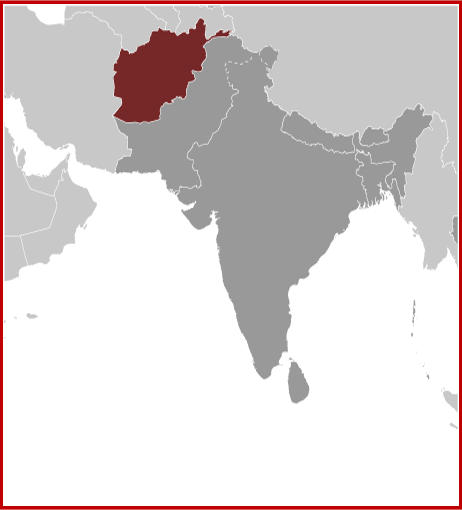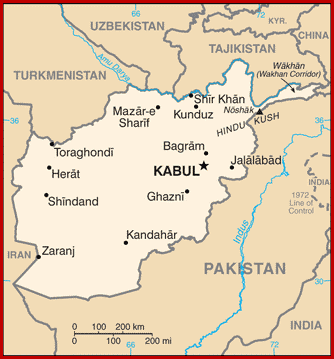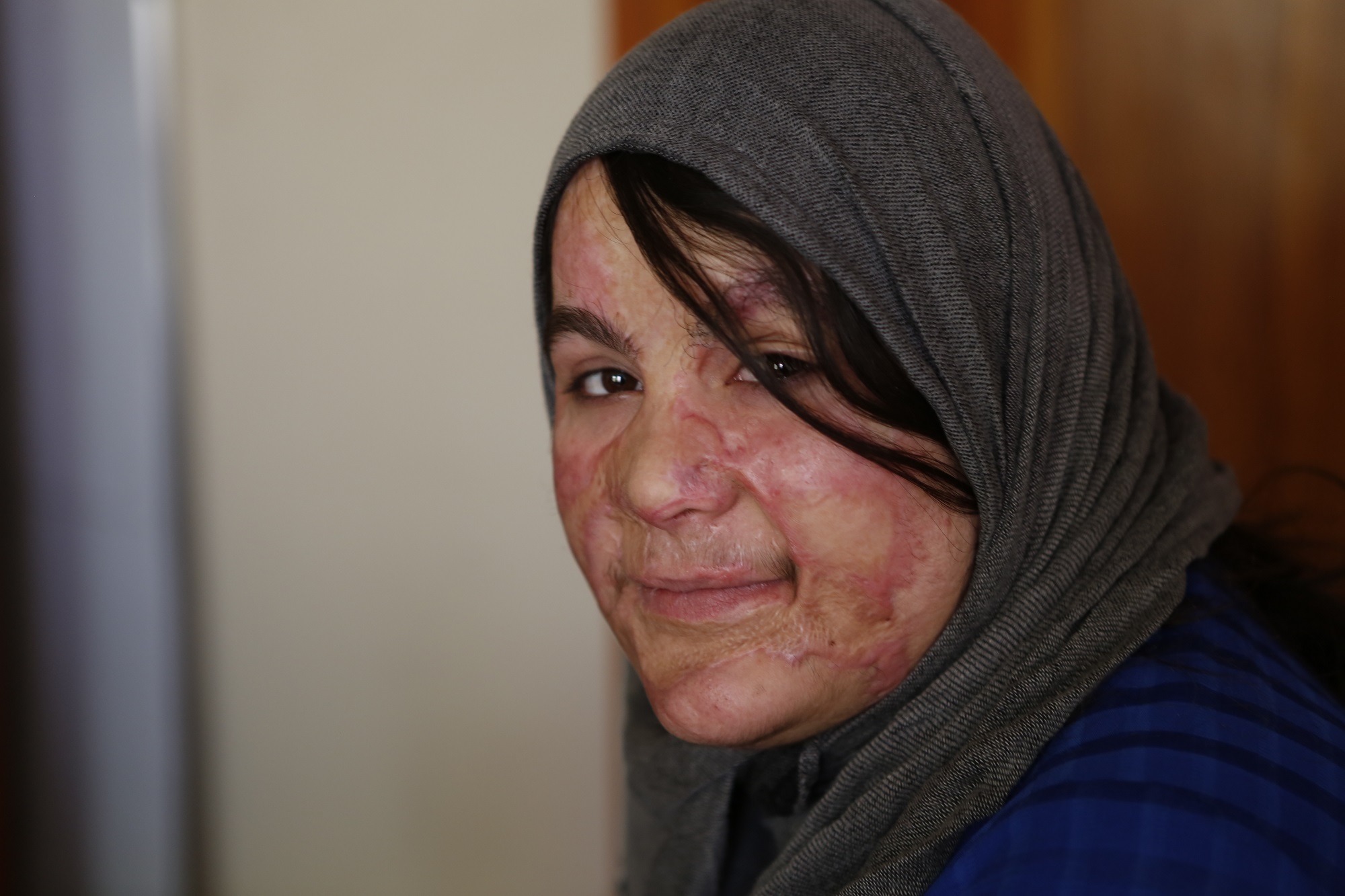
Mission
Women for Afghan Women (WAW) is a grassroots organization dedicated to securing and protecting the rights of disenfranchised Afghan women and girls in Afghanistan and New York. The organization allows these women and girls to develop their individual potential, to self-determination, and to be represented in all areas of life: political, social, cultural and economic. WAW advocates for women’s rights and challenges the norms that underpin gender-based violence wherever opportunities arise to influence attitudes and bring about change.
Life Challenges of the Women Served
Not long ago, Afghanistan’s women were educated and had rights. In fact, Afghanistan was sometimes referred to as the “Switzerland of Asia,” but things changed dramatically in 1979 when the Soviet Union invaded Afghanistan, setting off a destructive 10-year war. This led to a series of civil wars and, in 1996, the rise of the Taliban and its unspeakable brutality. Women were denied their basic human rights and life became desperate – and dangerous.
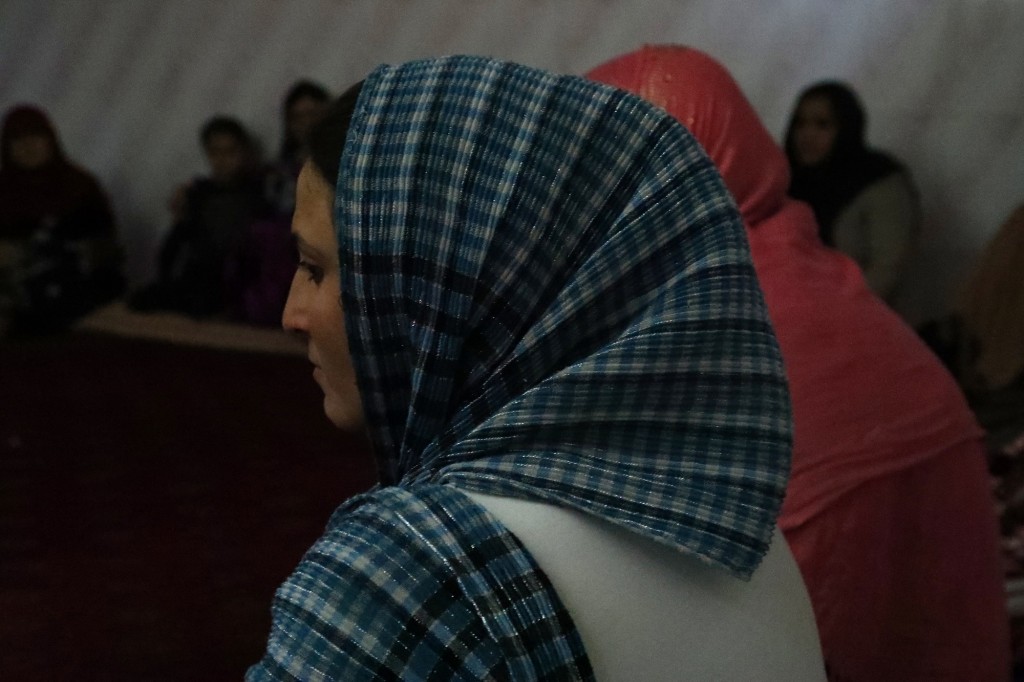
WAW Client taking a class at a Family Guidance Center (FGC) in Afghanistan.
Photo credit: Emilie Richardson
This reign of terror had little to do with Afghan culture or the spirit of Islam. The Taliban were a cult of medieval extremists: ignorant, uneducated, and brainwashed in an ideology that had very little to do with anything the Afghans knew and loved in their world – including their culture and religion. In many countries where there is a state of perpetual conflict – instability, dictatorship, upheaval, economic disparity, and attacks on human rights – the greatest challenge faced by Afghan women and the organizations that serve them is the difference between their legal rights and how or if those rights are acknowledged or implemented. For instance, the Afghan constitution guarantees equality for women and men, yet patriarchic practices persist that directly affect every aspect of Afghan women’s lives, including access to health care, education, love, family, and property.
In Afghanistan today, health services are primitive, and hygiene among medical professionals is poor. Resources are scarce, including basic medicine such as ibuprofen and other pain relievers, which are low quality, often expired, or completely void of potency. Malnutrition is commonplace, an especially dangerous reality for women who are pregnant or nursing. As such, women and children with acute medical needs are often in very real danger of not receiving the medical services they need to survive.
Unfortunately, Afghanistan has become one of the worst places on earth to be female. Nearly 90 percent of Afghan women experience gender-based violence, typically perpetrated by family members, and the deep-seated poverty makes it impossible for women to escape their situations. Afghan society is still primarily patriarchal with harmful social norms that directly violate women’s human rights, especially in rural areas. Women and girls are often forced to endure abuse, exploitation, homelessness, or imprisonment when they try to get out of these violent situations. Additionally, Afghanistan’s maternal mortality rate is the highest in the region. According to a joint United Nations report, women in the country have a 1 in 50 chance of dying from pregnancy-related causes.
The Project
DFW’s grant will allow WAW to provide its #ByHerSide Emergency Fund and Support Program, which provides life-saving services and intensive support to young girls and women suffering from rape, incest, abuse, violence, and/or pregnancies and births occurring outside of medical institutions. #ByHerSide will provide:
-
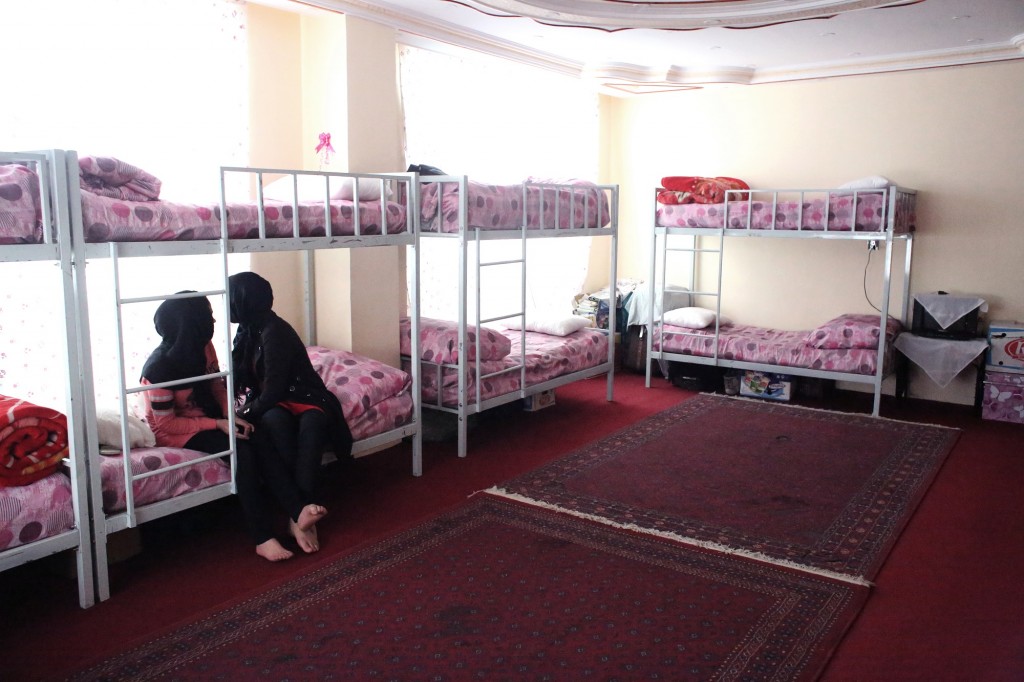
A rare glimpse into the peaceful, safe world of WAW’s clients taking a break in their room at WAW’s Halfway House.
Photo credit: Emilie RichardsonProtection and shelter against life-threatening violence: WAW offers women and girls facing violence from family members or others a safe shelter and anonymity in its Women’s Protection Centers, for as long as needed. In some cases, clients have stayed at the shelters for several years as the staff works to reconcile them with family members, or relocates them to other regions, provinces, or countries where they cannot be harmed.
- Critical medical services and procedures: WAW does not provide medical services, but it ensures the women and girls who come under its care receive medical services and the procedures they need to recover from gender-based violence or other reproductive health conditions. This includes emergency reconstructive surgeries, obstetric and gynecological services and exams, birth and after-birth services in a high-quality medical facility, and medicine and nutritional supplements to combat malnutrition. WAW connects clients with local medical providers, institutions, and WAW medical staff, covers the cost of all services and procedures, and offers transportation and accompaniment to medical appointments or surgeries. WAW stays by each client’s side during the healing process. Once fully recovered, WAW continues to provide any additional needs and covers any expenses that might surface. In addition, WAW rallies community members to provide blood donations and other assistance.
- Intensive emergency and safety counseling: WAW provides experienced, intensive guidance and counseling when women and girls are facing crisis situations. The goal is to keep women and girls safe when their lives are being threatened by family members or others in the community.
- Rescue and transportation: WAW’s brave and dedicated staff will arrange a safe location to pick up a client and transport her to a local medical facility or WAW Protection Center. These rescues can take place at any hour or day of the week.
- Successful (safe) reintegration into the community: Afghanistan is a family-oriented country. Often the women and children WAW serves want to return to their families, to be with their loved ones and find a way to safely resolve conflicts. WAW works with these women and their families to explore a safe reconciliation and reintegration. Most often, reintegration is possible. When safety cannot be guaranteed or does not feel possible, WAW helps the women and children understand that in order to survive, a new path and new life must be developed. WAW will stay with them until that life is possible and realized.
- Educational programming to bolster self-sufficiency: Once a client is stable, safe, and ready to think about the future, WAW offers educational programming focused on building literacy skills, life skills, civic participation, and vocational aptitude.
#ByHerSide will be offered in 14 Afghan provinces: Badakhshan, Baghlan, Balkh, Faryab, Herat, Jawzjan, Kabul, Kapisa, Kunar, Kunduz, Nangarhar, Samangan, Sari Pul, and Takhar. It will be available to women and girls already staying at one of WAW’s 12 Women Protection Centers, which serve approximately 4,500 women and girls annually, all of whom are survivors of intimate partner and/or domestic violence. It will also be available to 40,000+ women identified as Internally Displaced Persons (IDP) or are refugees staying at camps or makeshift villages in the seven North and Northeast provinces in Afghanistan where WAW has a presence. In WAW’s experience, every year about 500 women will require urgent support. These are the extreme cases, which also require a high level of safety planning as these women and girls have often escaped extremely dangerous, life-threatening circumstances. WAW has 10 years of experience providing effective services within these realities. The organization is allied with government officials and other agencies, and it is trusted by the broader community.
The one-year program will have a direct impact on 500 women and girls. As the household size in Afghanistan averages seven people, WAW estimates 3,500 will be indirectly impacted. It is anticipated that 250 women and girls will gain access to critical health services, at least 10 (up to 20) women and girls will be provided funding for emergency medical procedures and/or care, 250 women and girls will receive shelter and/or intensive support services while recovering from gender-based violence, and 250 women and girls will receive educational programming to strengthen life/literacy/vocational skills to improve self-sufficiency.
Launching the official #ByHerSide program will enable WAW to track these specific cases, measure the impact, and fundraise specifically for its continuation and expansion. Looking to the future, the program would potentially include mobile clinics, reproductive health training for community members and medical professions, and health kits distributed at WAW facilities and within refugee camps and IDP villages.
Direct impact: 500, Indirect impact: 3,500
UN Sustainable Development Goals
![]()
![]()
Questions for Discussion
- What do you think has made WAW so successful?
- Why do you believe that the Afghan Women’s Center in Queens is successful in its outreach and what special need does it serve for its community?
- What do you think must occur before these women can safely reintegrate back into their families?
How the Grant Will be Used
DFW’s one-year $50,000 grant will support critical components of #ByHerSide, including direct service staff in Afghanistan, emergency medical expenses, supplies for women and children staying in centers, facilities costs, travel expenses for rescue efforts and transport to medical providers, and indirect program costs.
Why We Love This Project/Organization
We love Women for Afghan Women’s emphasis on providing life-saving access to health services, safe shelter, and intensive support for approximately 500 young girls and women suffering from brutal instances of rape and incest, physical abuse or violence, or pregnancies and births. Their trusted presence across the country makes them a reliable service provider for women and girls.
Evidence of Success
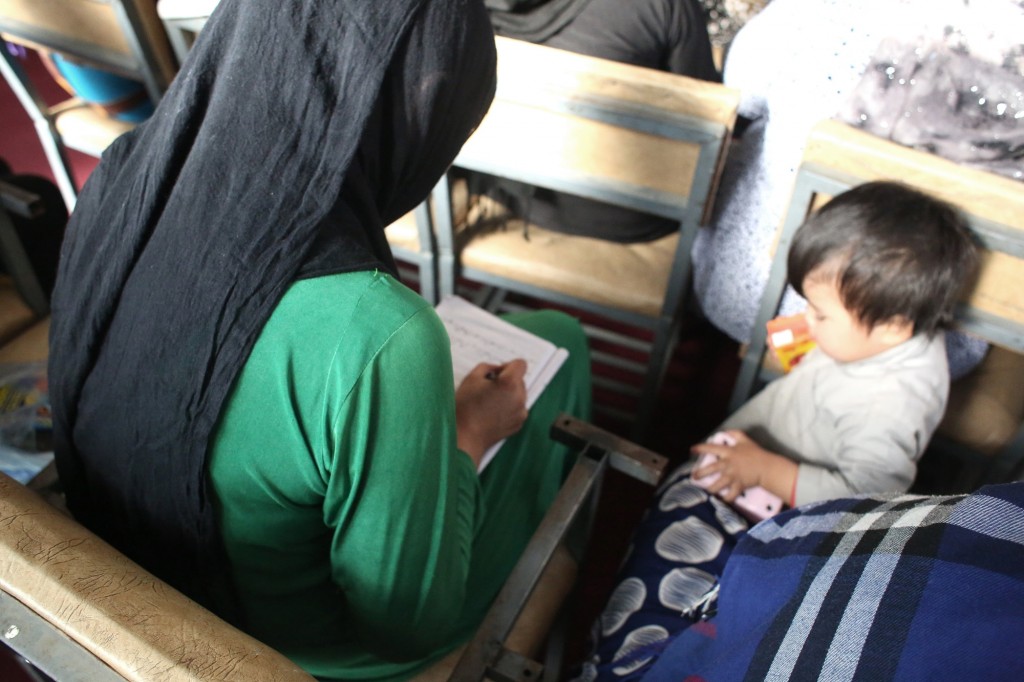
WAW client sits in class with one of her children at her side at one of WAW’s three Transitional Houses. Most of WAW’s clients are illiterate and go to school for the first time in their lives when they come to WAW. Many of them live at WAW facilities with their children for their safety.
Photo credit: Emilie Richardson
WAW is the largest women’s organization in Afghanistan, with more than 10 years of experience providing protection, safety, and loving care to over 25,000 women and children and 126,000 family members. WAW brings about change from the ground up, one family and one person at a time. Their expansive grassroots work for Afghans from all walks of life has begun to transform the culture of Afghanistan. As a result, Afghan community members, teachers, doctors, prison officials, police officers, and government agencies are becoming champions of women and girls. Women and girls are speaking out for themselves and reporting abuse instead of staying silent; communities are educated on women’s rights and advocate for fair treatment and independence for their wives, sisters, and daughters; and they are enforcing laws that protect women and girls despite threats to their safety and growing insecurity across the country. These are profound changes.
In 2016 and 2017, WAW received support from five major U.S. institutional funders: Carnegie Corporation of New York, Ford Foundation, The William and Flora Hewlett Foundation, The MacArthur Foundation, and the David and Lucile Packard Foundation. WAW also received increased general operating support funding from NoVo Foundation. These institutions believe in the impact of WAW and its potential to do even more to protect and serve women and children in Afghanistan, as well as to help invoke cultural change.
Voices of the Girls
WAW assisted in all of the following cases:
- Miriam was little over 3 years old when she was sexually assaulted. She was referred to WAW after her case received intense media attention. WAW took her to the hospital and persisted until she received needed surgery.
- Gita is 30 years old, the victim of extreme violence and abuse by her husband and her in-laws, including a beating that resulted in miscarriage when she was 8 months pregnant. WAW was contacted and admitted Gita to a hospital in Kabul, where she received blood transfusions needed to survive. WAW’s Kabul Family Guidance Center staff donated their own blood to make up for the shortfall. She soon recovered and was sent back to live with her parents.
- Mina was 9 years old when she was promised to another man by her father. Repeated sexual assault meant that she required surgery. The clinic referred her case to WAW. After months of medical care, she was moved to Kabul where medical facilities could better manage her condition. She finally underwent the surgery she required and is now recovering in one of WAW’s Women’s Protection Centers. Mina is now
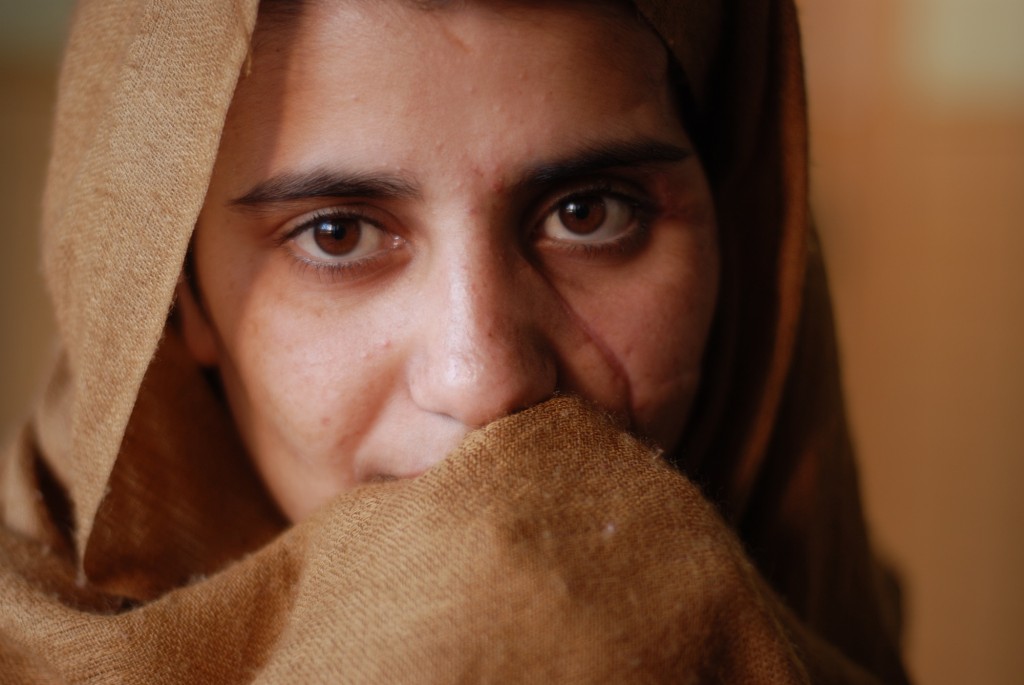
WAW Client, Gul Meena, at the WAW Women’s Protection Center where she was placed after recovering from a life-threatening ax attack inflicted by her brother and uncle in 2012.
Photo credit: Leslie Knottdoing much better and is healthy, but she will have to undergo further surgery when she is older.
- Sixteen-year old Marzia was repeatedly raped and ultimately impregnated by her own father. When Marzia went into premature labor, her mother rushed her to the hospital. The police referred her case to WAW, which took care of Marzia’s medical care. After her recovery, Marzia was placed in one of WAW’s women’s shelters, where she now attends literacy classes for the first time in her life. Her father has been arrested and sentenced to prison for his crime. Today, Marzia is not only safe, but also happy, and eagerly learning how to read and write with the dream of one day obtaining a university degree.
The New York Times covered story of Gul Meena, a young Afghan woman who was protected and served by WAW from 2012 – 2017. Story: https://www.nytimes.com/2012/12/02/world/asia/doctors-and-others-buck-tradition-in-afghan-honor-attack.html Video: https://www.nytimes.com/video/world/asia/100000005438452/a-child-bride-leaves-fear-behind.html
About the Organization
Women for Afghan Women (WAW) recognizes the connection between toxic masculinity and domestic abuse, between a twisted view of the Muslim religion and intolerance, and between patriarchy and violence. This is the heart and soul of WAW’s work with the women, men, girls, and boys they serve. WAW constantly strives to reach community members, particularly young people, with messages of love and compassion, peace and justice, and human rights training well before they encounter and fall under the sway of opposing messages of hatred and violence. WAW also constantly works to provide all who come to access its services with basic human needs and rights such as safety, dignity, respect, access to food, shelter, and health care, and access to education and opportunity.
WAW is known, respected, and has permission to operate 32 facilities within 14 provinces throughout Afghanistan. Additionally, WAW has permission to operate in refugee camps (for returnees) and in Internally Displaced Persons (IDP) villages throughout the North and Northeast regions of the country. WAW reaches a total of 88,000+ people through these refugee efforts, 40,000+ of whom are women and girls. In the U.S., WAW operates and serves a significant Afghan immigrant population in Queens, New York. WAW also conducts immigrant advocacy work in New York and Washington, DC.
This organization is led by Afghan women, many of whom are also survivors of gender-based violence, including its Executive Director, Manizha Naderi. WAW’s programs reflect a grassroots approach, always hiring locally to respect and understand local traditions, customs, and challenges. When conducting programming, WAW starts with a needs assessment and meeting with local community leaders, the district governor and other authorities, and religious leaders. This allows WAW to share program objectives, goals, and opportunities with them. This strategy builds support around WAW’s work and encourages local leadership involvement and participation. It also successfully gains local assistance in raising awareness about WAW’s programs with community members, constituents, and mosque congregations.
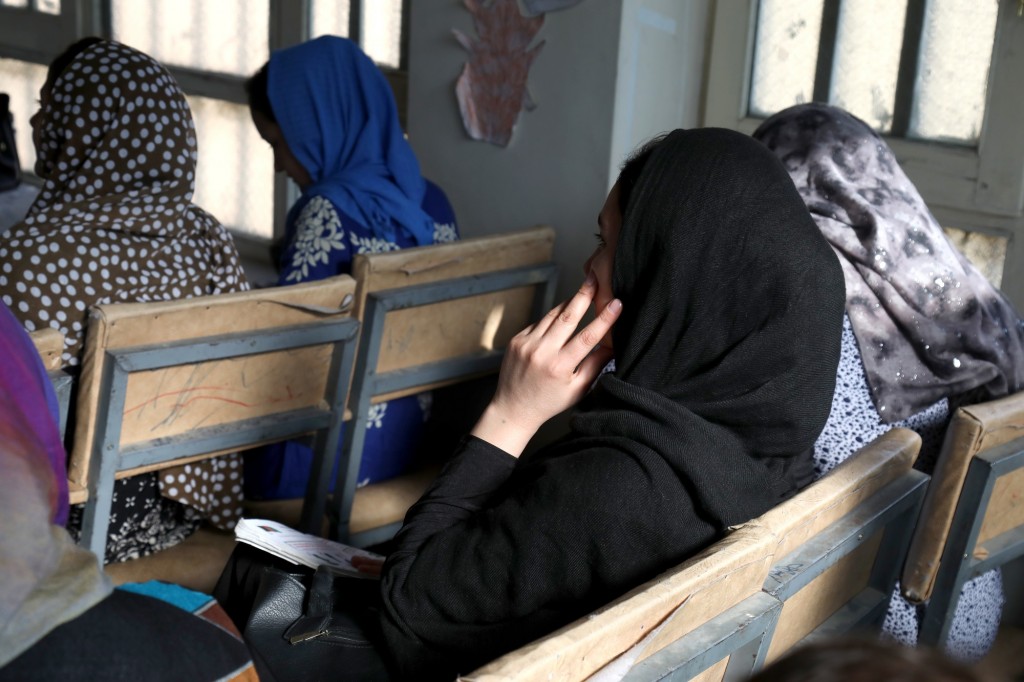
WAW clients in class at one of WAW’s three Transitional Houses. Most of WAW’s clients are illiterate and go to school for the first time in their lives when they come to WAW.
Photo credit: Emilie Richardson
WAW was founded in New York in April 2001 – six months before 9/11 – by a group of women determined to advocate for Afghan women then living under brutal Taliban rule. WAW co-founders quickly learned that Afghan women living in New York were enduring similar abuses as their sisters at home. The vast majority of families living in the NYC Afghan community are low-income, yet most were not receiving food stamps or job training, and almost none received public health benefits. Language and cultural barriers deterred them from seeking and obtaining services. With staggeringly low literacy rates among adults, children struggled to keep up in school and women and girls were victims of extreme gender discrimination and domestic violence.
As a response to the needs of the New York Afghan population, WAW launched the New York Community Center (NYCC) in 2003. The NYCC is strategically located in Queens, which is home to an estimated 90 percent of New York’s Afghan community, and is within walking distance for many clients, most of whom cannot afford or do not know how to use public transportation. WAW’s holistic programs include comprehensive case management for entire families, educational and empowerment programs for women and men, leadership development for girls and a new program for boys, and individual children’s tutoring.
By 2006, WAW was ready to take its direct service programming to Afghanistan. WAW’s Executive Director moved to Kabul and conducted a four-month feasibility study to determine the unmet needs of women and girls and to ensure that programming would enhance and complement existing work on the ground. The study showed there was an overwhelming need to provide women and girls with safe spaces and protection from human rights abuses. During that time, there were no women’s centers or shelters in the country and so WAW pioneered this model. WAW’s Afghan programming has since grown exponentially. Today, WAW is the largest women’s organization in Afghanistan, with over 750 local staff in 14 provinces operating 32 facilities.
WAW’s facilities, programs, and services in Afghanistan include 12 Family Guidance Centers providing family counseling, mediation, and legal representation to any person who has suffered a human rights violation; 12 Women’s Protection Centers offering women and girls safe and confidential homes until their legal cases are resolved; four Children’s Support Centers providing safe homes, stability, emotional support, and education for orphans and children whose mothers are in prison; three Transitional Houses providing women transitioning out of prison safe homes, education, counseling, and vocational training; and a Halfway House providing shelter, education, counseling, and vocational training to women transitioning out of centers or shelters who cannot safely return home. WAW also provides the “Women’s Rights ARE Human Rights” Training Program, providing education on the rights of women and girls under Islam and Afghan civil law for individuals at every level of Afghan society (over 305,000 people have been trained to date), and the Protection and Monitoring Project supporting local community reintegration efforts for conflict-induced internally displaced persons and refugee returnees, by strengthening the monitoring and efficacy of protection environments.
Where They Work
Afghanistan is a rugged landlocked country about the size of Texas that borders China, Pakistan, Tajikistan, Turkmenistan, and Uzbekistan. Most Afghans live in the foothills of the Hindu Kush range in the east, while some are scattered in the interior valleys. The south is sparsely populated. Nearly everyone is Muslim, predominantly Sunni (up to 90 percent) versus Shia. The population of 34 million is comprised of numerous ethnic groups and is young, with a median age of 18.8 compared to the US average of 38. Only 26 percent live in urban areas, compared to over 80 percent in the U.S. More than half are below the poverty line and just 38 percent are literate. Women have an average of five children, and the incidence of infant mortality is one of the highest of any country in the world. The average life expectancy is 50 for men and 53 for women.
Life in Afghanistan is not easy. Living standards are among the lowest in the world and there are shortages of housing, clean water, electricity, medical care, and jobs. Air and water pollution are evident in the urban areas, as is overgrazing and deforestation. Corruption is rampant, there is a lack of infrastructure, and the government does not maintain the rule of law evenly to all parts of the country.
Although there has been progress in building a stable government, the Taliban remains a serious ongoing challenge. This is because the Taliban still considers itself the true government of Afghanistan, and its ruthless means of making this point are evident even after its last two leaders were killed. Today, the Taliban claims it will only pursue a peace deal with Kabul after foreign military forces have left the country. Despite this inner turmoil, Afghanistan continues to recover from decades of war. Prior to 2014, its economy actually saw a decade of growth, mostly due to international assistance. Since the withdrawal of nearly 100,000 foreign troops in 2014, however, economic growth has slowed. The international community continues to show commitment to helping Afghanistan by pledging billions of dollars of aid. But for real change to occur, the government of Afghanistan must overcome many obstacles, including low revenue collection, scant job creation, significant corruption, among other problems.
Today, 44 percent of the workforce is in agriculture and one out of four is unemployed. Afghanistan produces wheat, fruits, nuts, and wool, and it’s the world’s largest producer of opium. Poppy cultivation has increased significantly in the recent past. The Taliban and other anti-government groups profit greatly from the opium trade, while corruption and instability impede anti-drug efforts. Not surprisingly, there is a growing opiate addiction problem inside Afghanistan as well. Recently, a national drug use survey showed that approximately 11 percent of the population tested positive for one or more illegal drugs.
A closer look at the difficulties women face in getting healthcare services in a male-dominated society
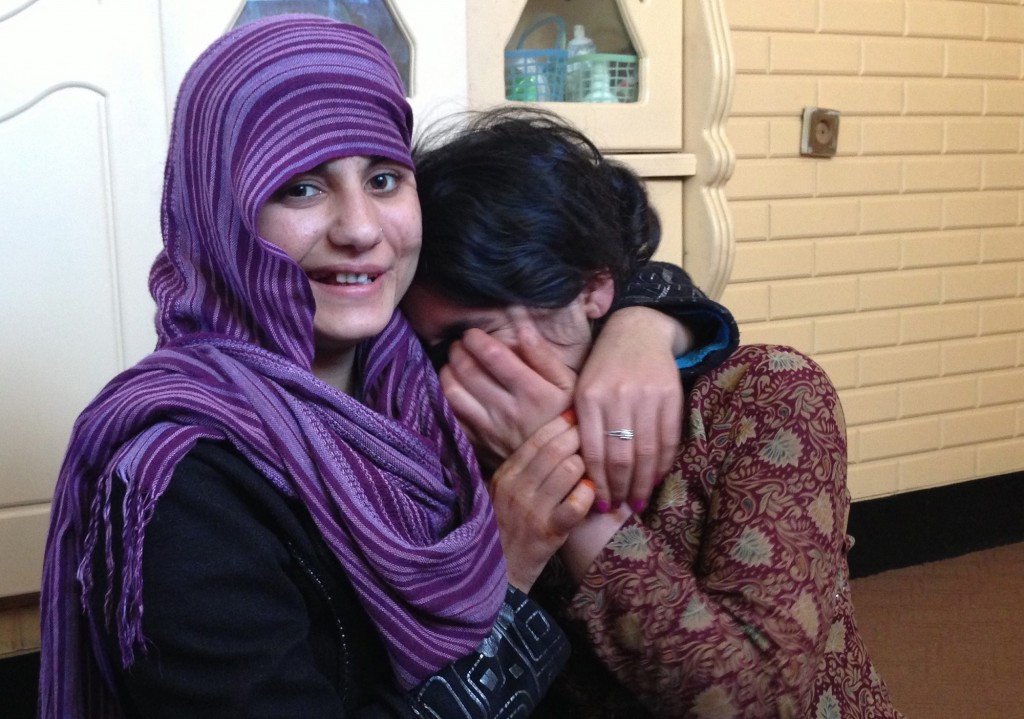
WAW Client, Gul Meena, joking around with her friend at the WAW Women’s Protection Center where both clients lived.
Photo credit: Leslie Knott
When women are denied services available to men, it denigrates their standing in society, perpetuates gender inequality, and, depending on the service in question, it can affect a woman’s physical and emotional well-being. Healthcare is a prime example. For instance, sexual and reproductive health issues account for a third of health problems for women ages 15 – 44, and unprotected sex is a key risk factor.
Worldwide, over 200 million women would like to avoid pregnancy, yet many are discouraged or prevented from using contraceptives. Approximately 300,000 women die every year from complications in pregnancy and childbirth; sadly, most of these deaths are preventable. Further, helping women avoid early pregnancy would allow them to stay in school longer and maybe even join the labor force. For many, all bets are off once the inevitable pregnancy arrives: women are conscripted to domestic life while their husbands maintain the outside lives they have built. Sometimes that comes with a heaping dose of servitude in cultures that are heavily male-centric. This inequality becomes the norm, and the cycle continues as the children look on. Like the Afghan women served by WAW, a life dominated by men can sink into violence. Today, a third of women under 50 have endured physical and/or sexual violence.
Gender inequality and a lack of access to healthcare also affects a woman’s vulnerability to HIV. Many women are prevented from HIV testing, counseling, and treatment. If their HIV status is known, disclosing it is completely off limits. Yet they bear a serious brunt. Today women and girls ages 15 – 49 comprise almost half of the infected population worldwide, and almost 60 percent in sub-Saharan Africa. Women are not only susceptible to HIV and at risk of it becoming fatal, but also to tuberculosis, which is the leading cause of death in low-income countries for women between the ages of 20 and 59.
Whatever the root cause, illness, or other healthcare concern, there is no denying that a woman’s emotional and psychological well-being are often compromised as well. Studies show that women are more likely than men to experience anxiety and depression. For that reason, it is imperative that access to quality mental healthcare be readily available. Sadly, this is not an option for the vast majority of women around the world.
Source Materials
https://www.usaid.gov/what-we-do/global-health/cross-cutting-areas/gender-equality
http://www.who.int/life-course/news/commentaries/2015-intl-womens-day/en/
https://www.cia.gov/library/publications/the-world-factbook/geos/af.html

